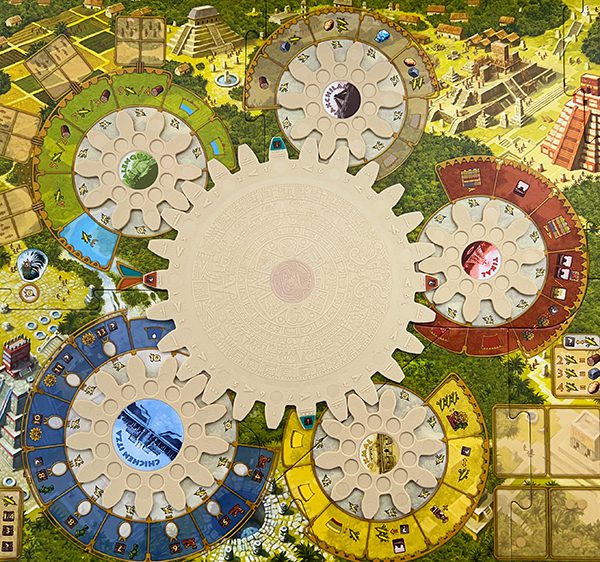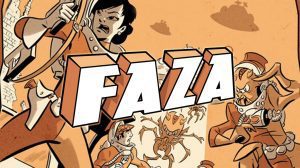In 2012 there was conjecture that the world would end because the ancient, carved stone circle that is the Mayan Calendar, ended in December of that year. It was the biggest End of Things speculations since 1999’s Y2K disaster that also never happened.
That same year, designers Danielle Tascini and Simone Luciani released Tzolk’in. It was easily the best—and most lasting—thing to come out of the public fascination with the Mayan Calendar that year.

Tzolk’in is played over a large, colorful board. The most predominant feature on that board is a series of spoked wheels that have become synonymous with the game. Score the most points at the end of the game and you’ll win.
Set Up
First, build the board from the four puzzle pieces included in the box. (Seriously) Then position each of the six gears in their correct space on the board.

Choose a color and take all the markers for that color. Take the flat markers and place one on each of the three god Tracks in the upper right corner, one on each of the four Technology Tracks. Place three of the taller markers in front of you, leaving all the others in easy reach.
Set out all the cubes for the three resources: wood, stone and gold, to the left of the god Tracks Set all the blue crystal skulls there as well. Place the round disks with the corn icon within easy reach of all players.

Deal out six Monuments to the spaces just below the Technology Tracks. Do the same with the Buildings, just below them.
Deal each player four Starting Wealth tokens. Choose two to keep, taking the listed resources/actions, and place the others back in the box.
Now you’re ready to start playing.
How to Play
Each player starts with three workers. On each turn, you must either place one or more workers on an available slot on one of the five smaller wheels or remove one or more previously-placed workers from one of those same wheels. Placed workers remain on their wheel until removed; once removed, players may claim the action associated with their place on the wheel.
When all players have made their moves, the central wheel gets moved one day, or one gear tooth, counterclockwise. This, in turn, moves each of the five connected gears, and the workers placed on them, ahead one space. Then play continues, with players placing or retrieving workers.
If this sounds deceptively simple, that’s because it is. However, since this is a very well thought-out and challenging board game, there are complications.
Take corn, for example. Corn is the basic currency of Tzolk’in and is used for many things. Four times per game, your workers must be fed. Each worker consumes two corn from your supply. If you lack sufficient corn to feed your workers, the gods are displeased, and you lose points.
Corn is also used to place additional workers on the five wheels. Your first worker on a wheel gets placed for free, but each additional worker costs you another corn to place. If the Zero spot on the wheel of your choice is open, you may place a worker there for free. If not, each spot further along the wheel also costs you more corn to place a worker there.
The five wheels are each named after different cities and provide you with different resources.
- Palenque provides you with corn or wood.
- Yaxchilan provides an array of resources including corn, wood, stone, gold, and the skulls.
- Tikal allows you the opportunity to move ahead on the Technology tracks (providing you have the resources) to pay for the upgrade, or purchase a Building or Memorial, or move ahead on one of the god tracks.
- Uxmal allows you to use corn in additional ways, as well as allowing you to claim an additional worker.
- Chichen Itza is solely for the placement of blue skulls. Placing skulls gains you victory points, advances you on a specific god track, and may even grant you an additional resource.
The longer your workers stay on each wheel, the better the choices are.

For instance, if you place your worker on the Zero spot of the Yaxchilan wheel, on your next turn you can remove your worker and claim three corn. However, if you wait four turns you could claim seven corn. If you place a worker on the Zero spot on the Chichen Itza wheel, on your next turn you could place a blue skull (providing you have one) in the first spot and claim four points and move up one on a god Track. If you waited nine turns you could score 13 points, move up one on a god Track, and claim the resource of your choice.
Thoughts
With the simple dictate that you must either place or remove workers on each turn, Tzolk’in becomes a series of interesting decisions. Do you leave workers on a wheel for multiple turns to claim a better option? Or do you pull them off early to get that corn you so desperately need? And what about going after the resources necessary to advance on a Technology Track so corn is always available? Or buying that building so your workers need less corn on feeding days?
The moving gears and the opportunities available on them and your constant need for corn means you’ll need to spend much of your game thinking several moves ahead. However, an opponent’s move can easily mess up your carefully constructed plans either by claiming that essential slot on a wheel ahead of you or by fiendishly moving the central calendar wheel ahead two days instead of just one.

With such emphasis placed on the timing and position of your workers, it is easy to forget that Tzolk’in is won based on Victory Points. It turns out there are precious few scoring opportunities in the game. Players score points by placing blue skulls on the Chichen Itza wheel; by climbing up the three separate god tracks (which are scored twice during the game); and by exchanging any remaining resources at the end of the game for points.
I was initially suspicious of the gear mechanic in Tzolk’in. It, like the Mayan Calendar “prediction” of the End of the World, seemed a bit gimmicky. However, the central calendar gear works extremely well by progressing each worker ahead on each wheel simultaneously. This means the only potentially hidden element of the game is whether a player is going to take their once-per-game opportunity to move the calendar ahead by two days instead of one.
Tzolk’in is one of those games that I feel is just within my grasp. That’s part of what makes it so challenging, we’re each facing the same obstacles and issues. It’s just a question of who is going to manage our workers and resources in the best way to get those elusive points.
It’s also a game that, once I’ve finished playing, I need to take a short breather—and then I want to play it again.












Add Comment